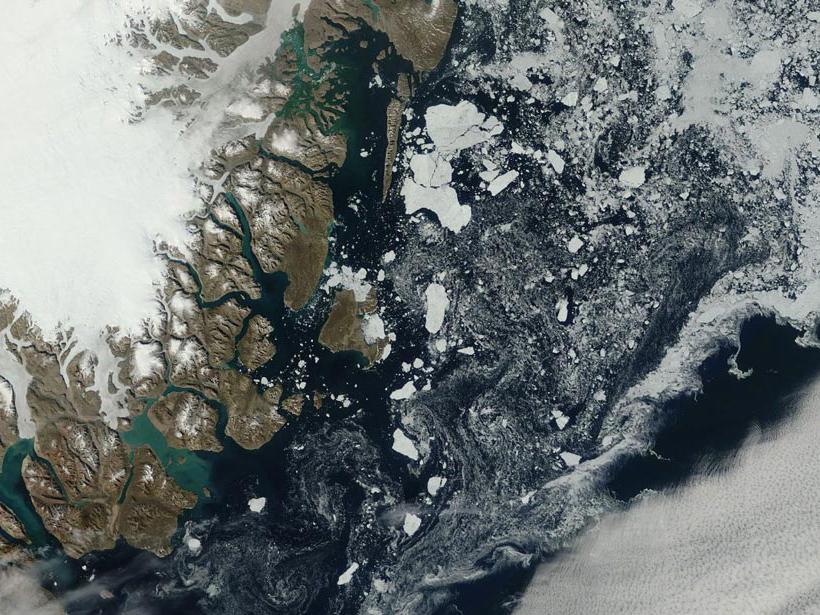As scientists attempt to understand how anthropogenic climate change will affect the Earth’s future, they often study a period in the Earth’s deep past, called the Paleocene-Eocene Thermal Maximum, when a period of natural climate change significantly heated the Earth. In a Nature Geoscience paper published Monday, scientists established that this warming, which began 56 million years ago, was the result of a 4000-year period in which carbon was released into the atmosphere at a rate of 1.1 petagrams (or 1.1 trillion kilograms) per year.
The Paleocene-Eocene Thermal Maximum is the biggest, most massive carbon release event since dinosaurs disappeared.
The Paleocene-Eocene Thermal Maximum (PETM) “is the biggest, most massive carbon release event since dinosaurs disappeared,” said Richard Zeebe, a biogeochemist and paleoceanographer at the University of Hawai‘i at Mānoa in Honolulu and lead author on the paper. Previous research had determined that this initial onset period stretched as long as 20,000 years, but Zeebe’s team used more highly resolved data to shrink this onset time by a factor of 5.
Because the rate of carbon dioxide release is 10 times faster today, the severity of climate change’s physical effects on the Earth, such as ocean acidification, could be much worse than we thought, Zeebe said.
A Different Earth
During the PETM, which lasted 100,000 years, Earth was a much different place than it is today. First and foremost, it was hotter, and the air contained much more carbon dioxide—700 parts per million, as opposed to today’s 400 parts per million. During the onset of the PETM, Earth’s temperature jumped because of a massive release of carbon dioxide (CO2). The leading hypothesis for this geologically sudden event is that extensive volcanism warmed the ocean during that time, melting deep ocean methane hydrates that released methane, a potent greenhouse gas. Most of this methane was rapidly oxidized and became carbon dioxide, Zeebe said.
“The interesting thing is that it is [possible] that nature, over the long geological history, has also run this experiment, i.e., the rapid emission of CO2 into the ocean [and] atmosphere, similar to what we humans are doing now,” said Ellen Thomas, a paleoceanographer at Yale University in New Haven, Conn., who was not involved in the research. Having a better idea of the rate of carbon emissions “will also help in figuring out exactly where the carbon came from and why it was released.”
Researchers see evidence of marine life extinction during this time due to ocean acidification, Zeebe said, especially in the deep-sea communities of tiny, shelled organisms.
Peeking into the PETM
To investigate how fast carbon was released, the researchers turned to an existing data set from a sediment core from Millville, N.J. This particular core offered the researchers much more highly resolved data than other cores used to investigate the ancient release. The layers of sediment laid down during the PETM at the New Jersey site are much thicker—tens of centimeters—than the thinner layers that other sediment cores offer to scientists, Zeebe said.
Different isotopes of carbon and oxygen locked within the sediment tell scientists a lot about past environments: A lower ratio of the heavier carbon isotope to the lighter isotope represents the time period in which carbon was emitted, and a lower abundance of the heavy oxygen isotope corresponds to the warming temperatures.
When carbon rises in the atmosphere, the ocean absorbs much of the resulting heat, so the climate can take decades to centuries to fully respond to an influx of carbon, Zeebe said. If carbon were released rapidly, researchers would find in the sediment core a lag between the carbon influx and warming temperatures. On the other hand, if carbon were released slowly, the climate’s response would have kept pace with the carbon increase because of the ocean’s slow adjustment, resulting in no lag.
The researchers found no lag between the massive carbon emission and the climate response, meaning that carbon was released relatively slowly compared to today.
Within the sediment core, the researchers found no lag between the massive carbon emission and the climate response, meaning that carbon was released relatively slowly compared to today.
Using climate and carbon cycle computer models, the researchers tweaked the amount of carbon and the rate of carbon emission to match the physical data they found in the sediment core. What they found was that the PETM onset lasted, at minimum, 4000 years.
Future Climate Change
“This study provides another indication…that the rate of fossil fuel emissions significantly exceeds rates of carbon emissions during the PETM,” said Lee Kump, a biogeochemist at Pennsylvania State University in University Park, who wasn’t involved in the research, in an email.
In fact, Kump and his colleagues published a paper in Nature Geoscience in 2011 that determined that today’s rates of carbon dioxide emissions are 10 times higher than those during the onset of the PETM. Because the ocean absorbs much of the carbon dioxide, the consequences for marine life, especially shelled creatures, could be worse than during the PETM, Zeebe said.
Further, if carbon emissions are not reined in, natural feedbacks, such as the Earth’s decreasing albedo due to melting ice and releases of methane from thawing permafrost, could spiral out of control with unknown consequences.
“There is no other cure than reducing emissions,” Zeebe said.
—JoAnna Wendel, Staff Writer
Citation: Wendel, J. (2016), Current carbon emissions unprecedented in 66 million years, Eos, 97, doi:10.1029/2016EO048873. Published on 23 March 2016.
Text © 2016. The authors. CC BY-NC 3.0
Except where otherwise noted, images are subject to copyright. Any reuse without express permission from the copyright owner is prohibited.

